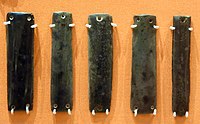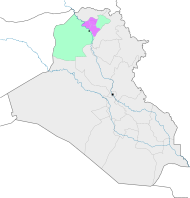Tell Arpachiyah
Nineveh Province, Iraq | |
| Region | Northern Mesopotamia |
|---|---|
| Coordinates | 36°22′17″N 43°11′52″E / 36.37139°N 43.19778°E |
| Type | tell |
| Site notes | |
| Excavation dates | 1933, 1976 |
| Archaeologists | M. Mallowan, J. Cruikshank Rose, I. Hijara |
Tell Arpachiyah (outside modern
Nineveh Province (Iraq). It takes its name from a more recent village located about 4 miles (6.4 km) from Nineveh
. The local name of the mound on which the site is located is Tepe Reshwa.
Tepe Gawra is also a contemporary Neolithic site located in the Mosul region.
Archaeology
Tell Arpachiyah is a small
tholoi and the "Burnt House". An array of Halaf pottery and sealings were also found, along with an Ubaid cemetery containing 50 graves.[4]
Occupation history

The site was occupied in the Halaf and Ubaid periods. It appears to have been heavily involved in the manufacture of pottery. The pottery recovered there forms the basis for the internal chronology of the Halaf period.
Gallery
-
Obsidian jewelry. It is unknown whether they were sewn to clothing or they were joined together to make a necklace, bangle, or belt. 6000-5000 BC
-
Jar. The surface is painted with lustrous black paint on a salmon-pink slip. Halaf period, 6000-5000 BC
-
Bowl. The bowl was found fragmented and the pieces were scattered over the floor. 6000-5000 BC
-
Shallow plate. The interior is decorated with a floral design in the center, with polychrome in black and red on the buff surfaces. 6000-5000 BC
-
Sherd. The exterior is painted with a design; lustrous black paint on apricot-coloured clay with a burnished surface. The design of spotted animals possibly represents leopards
See also
- Cities of the ancient Near East
- Come, Tell Me How You Live
References
- ^ Max Mallowan, John Cruikshank Rose, Excavations at Tall Arpachiyah 1933, Iraq, vol. 2, pp. 1-178, 1935
- ^ Ismail Hijara, Arpachiyah 1976, Iraq, vol. 42, no. 2, pp. 131-154, 1980
- ^ Ismail Hijara, Three New Graves at Arpachiyah, World Archaeology, vol. 10, no. 2, pp. 125-128, 1978
- ^ Mallowan, M. E. L., and Hilda Linford, "Rediscovered Skulls from Arpachiyah", Iraq, vol. 31, no. 1, pp. 49–58, 1969
Further reading
- Catherine Breniquet, "A Propos Du Vase Halafien de La Tombe G2 de Tell Arpachiyah", Iraq, vol. 54, pp. 69–78, 1992
- Hijara, Ismail. The Halaf Period in Northern Mesopotamia, Nabu, 1997, ISBN 1-897750-06-4
- Stuart Campbell, The Burnt House at Arpachiyah: A Reexamination, Bulletin of the American Schools of Oriental Research, no. 318, pp. 1–40, 2000
- Peter M. M. G. Akkermans, Glenn M. Schwartz, The Archaeology of Syria: From Complex Hunter-gatherers to Early Urban Societies (c. 16,000-300 BC), Cambridge University Press, 2003, ISBN 0-521-79666-0
- T. Davidson and H. McKerrell, The neutron activation analysis of Halaf and Ubaid pottery from Tell Arpachiyah and Tepe Gawra, Iraq, vol. 42, pp. 155–67, 1980






